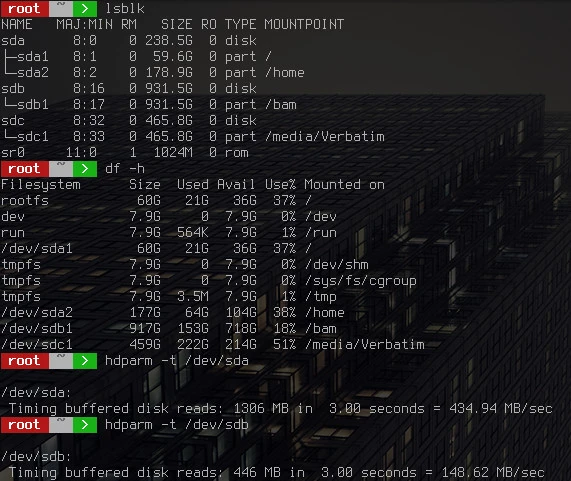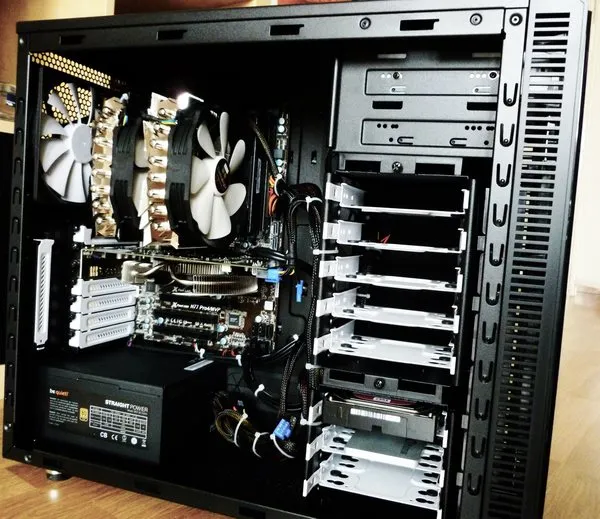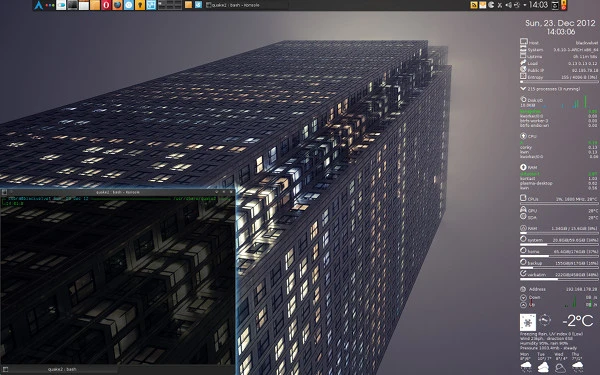Heavy metal
The first thing I notice is its weight: the 'Fractal Design R4' is a hefty 12.3 kg, more than twice than my previous case which is not much smaller, but consists of rather thin and flimsy aluminum sheets. The matted black side panels of the R4 are made of remarkably thick rolled steel, and are additionally fit with dense bitumen inlets for sound suppression which add to the overall weight.
Inside, the massive Thermalright Silver Arrow dominates the visual impression, but one can also perceive the cooler of the GPU just below, the power supply at the bottom, and the two drives at the bottom right.
Once powered up, the system starts with an audible hum, definitely not as I've expected. I first reduce the speed of the case fans with the external switch, but that just leads to a slight change of the tune of the hum. The case fans, when fully turned up, only emit the characteristic noise of high air flow, but the hum is clearly of different origin. I thus enter the systems BIOS and set the default CPU fan speed from 7 to 1. After a restart, the hum is gone.
In fact, I now can't tell if the system is actually powered up. I need to close the windows and strain my ears, and still come closer than about 1 m to register that it is alive. That's just as I hoped it would be. Right now, of course, the system is just idling, and there's no load yet.
Prior to put a load on the machine, I need to install an operating system. Needless to say, that will be Archlinux. There have been a lot of new developments since I have done so the last time, namely, GPT instead of MBR (and thus gdisk instead of fdisk), btrfs instead of ext4 (a least for the system partition), syslinux instead of grub, systemd instead of sysvinit, and of course, the abandonment of the Arch Installation Framework in favor of the Arch Install Scripts.
I just follow the instructions and am rewarded within 30 min with a running system without encountering a single problem. Note that I've never used the Arch Install Scripts nor any other of the new paradigms mentioned above. So much for all the whining in the Arch forums. 😉

After the set up, it is the very high speed of the SSD (see the numbers for /dev/sda above) which dominates the first impression. This high speed results in a boot time of 5 s when measured from the syslinux menu to the KDE login, and another 7 s from this login to a fully loaded KDE desktop. That's really very fast, but I actually couldn't care less: I reboot my system perhaps once a month, if at all.
What's important in the actual everyday operation of the system is not the high transfer rate of the SSD, but rather its very low access time. Thanks to the low latency, and the potentially very high I/O rate, the system feels actually even faster than the above numbers suggest. The result is an overall 'snappiness' of the system which cannot be achieved by merely using faster processors or graphic cards.
But these latter factors contribute to the actual , objectively measurable speed. For example, (multicore) transcoding is 2 times faster than on my wife's i750, and thus 6 times faster than on my old E6600. The (singlecore) Mathematica Benchmark is 2 times faster than for a i7 950, and 3 times than for a E6600. During these benchmarks, the CPU fans spin up from about 650 to 900 rpm and keep the CPU below 50°C. Even at full load, the system remains essentially inaudible.
And what about games? Well, I've installed the usual suspects (Nexuiz, Xonotic) and they run at the highest possible settings with the display maxed out at all times. I hope nobody tells my wife that the 650Ti, despite its modest appearance and miniature size, is actually faster than her GTX260. 😉
In any case, I've discovered yamagi-quake and just fight my way through ancient monsters made more presentable by high-resolution texture packs but nevertheless remaining what they are: clumsy creatures of the 90s without even a shred of intelligence. I adore them. 😉
And for completeness, my desktop with the inevitable conky. The CPU speed is an average over the 8 available cores (cpu0 in conky lingo).

